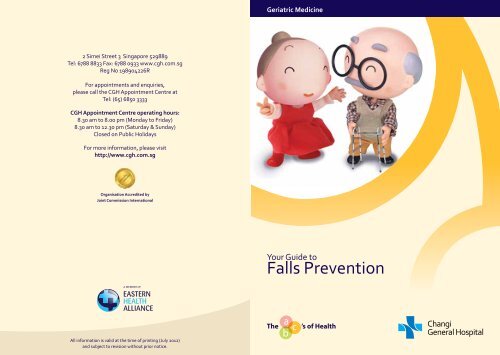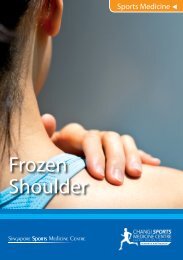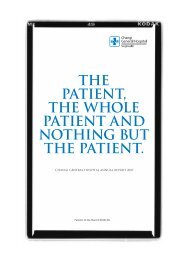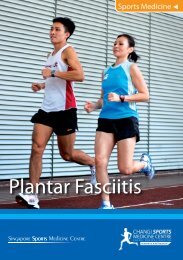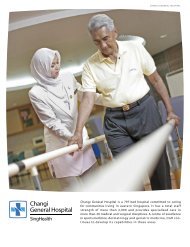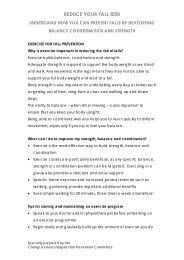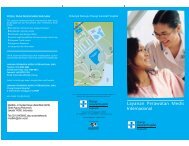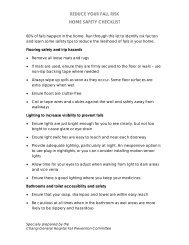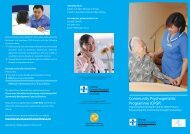Fall Prevention Brochure - Changi General Hospital
Fall Prevention Brochure - Changi General Hospital
Fall Prevention Brochure - Changi General Hospital
You also want an ePaper? Increase the reach of your titles
YUMPU automatically turns print PDFs into web optimized ePapers that Google loves.
Geriatric Medicine<br />
2 Simei Street 3 Singapore 529889<br />
Tel: 6788 8833 Fax: 6788 0933 www.cgh.com.sg<br />
Reg No 198904226R<br />
For appointments and enquiries,<br />
please call the CGH Appointment Centre at<br />
Tel: (65) 6850 3333<br />
CGH Appointment Centre operating hours:<br />
8.30 am to 8.00 pm (Monday to Friday)<br />
8.30 am to 12.30 pm (Saturday & Sunday)<br />
Closed on Public Holidays<br />
For more information, please visit<br />
http://www.cgh.com.sg<br />
Organisation Accredited by<br />
Joint Commission International<br />
Your Guide to<br />
<strong>Fall</strong>s <strong>Prevention</strong><br />
A MEMBER OF<br />
All information is valid at the time of printing (July 2012)<br />
and subject to revision without prior notice.
1<br />
w<br />
2<br />
Don’t fall for it<br />
While it is true that falling down is a common occurrence in life and the risk<br />
increases as we get older, falls are not a natural part of ageing and can be<br />
prevented.<br />
Why is fall prevention important? This is because:<br />
Get a QR code reader app from your smartphone’s<br />
app store (“search QR reader”) and scan this code<br />
using the app, or visit : www.cgh.com.sg/nofalls<br />
to read more about how to prevent falls.<br />
1. <strong>Fall</strong>s that happen in the older age group have a greater risk of causing injury.<br />
2. The injuries sustained can also be long lasting and reduce the ability to walk<br />
and move, affecting confidence and independence.<br />
3. A large number of falls in seniors can result in long hospital stays and<br />
expensive surgeries.<br />
Don’t let falls affect your life, read this booklet and say no<br />
to falls today!
3 4<br />
Contents<br />
4 Why we fall<br />
5 Ageing and falls: Our changing bodies<br />
7 <strong>Fall</strong> proof your environment<br />
9 <strong>Fall</strong> proof your bedroom<br />
11 <strong>Fall</strong> proof your kitchen<br />
13 <strong>Fall</strong> proof your bathroom & toilet area<br />
14 Walk safe: Proper footwear and walking aids<br />
15 Useful fall prevention products<br />
17 Getting up from a fall: What to do if you are alone<br />
19 Getting up from a fall: How to help someone who has fallen<br />
21 Getting help: Your action plan<br />
22 When to call an ambulance<br />
Why we fall<br />
There are many reasons why falls happen. Some of the factors which can cause<br />
falls are listed below:<br />
1. Physical factors<br />
– these are usually a result of<br />
changes due to ageing or some<br />
medical conditions<br />
2. Medical conditions<br />
which can pre-dispose to falls<br />
• Muscle weakness or pain<br />
• Slow reaction time<br />
• Poor balance<br />
• Reduced vision<br />
• Poor memory<br />
or concentration<br />
• Dizziness<br />
• Parkinson’s disease<br />
• Stroke<br />
• Dementia<br />
• Arthritis<br />
• Rheumatism<br />
• Incontinence<br />
• Diabetes<br />
3. Lifestyle reasons • Lack of exercise<br />
• Poor diet<br />
• Unsuitable footwear or attire<br />
4. Environmental factors • Poor lighting and visibility<br />
• Cluttered spaces, narrow walkways,<br />
physical obstacles<br />
• Staircases, steps, steep inclines and<br />
curbs<br />
• Slippery surfaces such as wet floors<br />
To manage and reduce your risk of falling due to medical conditions or use of<br />
medications, you need to ensure that your medical conditions are optimally<br />
treated. Visit your doctor for regular review.<br />
Understanding these fall risk factors is the first step in preventing falls. In the next<br />
few pages, we will explain how some of these factors contribute to the risk of<br />
falling – and more importantly, how to do away with these hazards.
5 6<br />
Ageing and falls:<br />
Our changing bodies<br />
As we age, our bodies change – our eyesight may dim and we may not be<br />
as nimble as before. Stairs and curbs may become harder to manage as our<br />
balance becomes poorer. Moving around may take longer. We might become<br />
more forgetful. These changes are a natural part of growing older.<br />
Ageing is normal – falling is not; understanding your personal risk factors can<br />
help you remain active and independent safely.<br />
Keep an eye out for poor vision<br />
Good vision is important for identifying and avoiding obstacles, sharp corners,<br />
steps and curbs. Good vision in both eyes is also crucial in judging distances and<br />
depth to help navigate stairs and uneven terrain.<br />
Here are some tips to maintain good vision:<br />
• Have your eyes checked every year by an eye doctor or optometrist<br />
• Wear only a single-lens pair of glasses (i.e. no bifocals, trifocals or multifocals)<br />
when walking, especially when outside the home. Wear bifocals, trifocals or<br />
multifocals with caution as these vision aids blur obstacles on the ground,<br />
creating a ‘blind spot’ that can cause tripping<br />
• Always wear your glasses and keep them near you<br />
• Wear a hat and/or sunglasses when outside, especially in bright and high<br />
glare situations.<br />
• Avoid dimly lit areas if possible and turn the light on before walking in the<br />
house at night<br />
• Put on your glasses if you get up in the night to go to the toilet.<br />
• If you have cataracts which are suitable for surgery, having the operation is<br />
likely to improve your vision
7 8<br />
<strong>Fall</strong> proof your environment<br />
Sixty per cent of falls happen in the home. In order to continue to live safely and<br />
independently, our homes have to ‘grow’ with us. Making simple modifications<br />
to our environment, especially at home, can go a long way in reducing the<br />
risk of falls.<br />
There are two main ways to reduce fall hazards in the home:<br />
1. Adapt your environment to increase safety<br />
2. Increase your perception and awareness of your environment<br />
<strong>General</strong> Principles<br />
Take note of these general principles to ensure that they don’t cause a fall.<br />
These apply to ALL areas of the home:<br />
Floor and walkway safety<br />
• Ensure floors and walking areas are clear and clutter-free.<br />
• Remove trip hazards such as loose mats and rugs, stray wiring, furniture that<br />
blocks walkways, standing fans and toys.<br />
• If using mats or rugs, make sure they are secured to the ground.<br />
• Wipe up spills as soon as they occur.<br />
• If you have pets, be wary in case they get underfoot.<br />
Keep things within reach<br />
• Ensure that heavy items or items used frequently are within easy reach.<br />
You should not need to climb, bend or reach too far for these items.<br />
• Only if absolutely necessary, use a broad based sturdy and secure ladder<br />
to reach high places. Do not stand on stools and chairs to reach the high shelves.<br />
• Place your telephone within easy reach; cordless telephones are recommended.<br />
Keep dangers in sight<br />
• Highlight the edges of obstacles or changes in floor height by sticking<br />
brightly coloured tape on these edges.<br />
• Furniture colours that contrast with the walls and the floor can help you to<br />
be more aware of your surroundings.<br />
• Avoid installing heavily patterned floor coverings and furniture.<br />
Let there be light<br />
• Ensure lights are just bright enough for you to see clearly, but not too bright<br />
to cause glare or eye strain.<br />
• Ensure light switches are easy to reach and near each doorway.<br />
• Provide adequate lighting, particularly at night. Options such as plug-in<br />
nightlights, or motion sensor lights are worth considering.<br />
• Allow time for your eyes to adjust when walking from light to dark areas and<br />
vice versa.<br />
<strong>Fall</strong> proof your wardrobe<br />
• Check that clothing ends are above the ankle to avoid tripping.<br />
• Sit down rather than stand when dressing.<br />
• Avoid walking around in your socks.
9 10<br />
<strong>Fall</strong> proof your bedroom<br />
Use a cordless phone to help<br />
you make phone calls without<br />
getting out of bed. A cordless<br />
door bell may be used to call for<br />
help.<br />
Install a night light.<br />
Consider placing a commode<br />
or urinal next to the bed at<br />
night to avoid the need to<br />
walk when sleepy.<br />
Ensure that the bed is of a correct height.<br />
You should be able to place your feet<br />
flat on the floor when you sit at the<br />
edge of the bed.<br />
Place walking aids close to<br />
the bed.
11<br />
w<br />
12<br />
<strong>Fall</strong> proof your kitchen<br />
Place utensils and commonly<br />
used items within easy reach<br />
at chest or waist level.<br />
Have good, non-glaring lighting<br />
over the counter top and stove,<br />
especially when food is being<br />
sliced or cut.<br />
Turn in long handled<br />
utensils when cooking.<br />
Reduce glare by using shades or indirect lighting.<br />
Install additional lighting if needed.<br />
Clean up spills immediately.<br />
Store heavy items or<br />
frequently used items<br />
within easy reach or in<br />
lower cabinets.<br />
Do not stand on stools<br />
and chairs to reach the<br />
high shelves.
13<br />
14<br />
Walk safe:<br />
Proper footwear and walking aids<br />
With age, our feet may change shape, be prone to swelling or loss of feeling.<br />
Combined with other changes in muscle strength and balance, the risk of falls<br />
increases. Hence, it is important to wear appropriate shoes.<br />
Safe shoes<br />
The ideal shoe should fit well, be flat, broad-based and have non-slip soles.<br />
• Buckles, Velcro straps,<br />
and laces help to<br />
ensure a snug and<br />
safe fit. Be mindful of<br />
laces when walking<br />
• Heel cup should be<br />
low, wide and have a<br />
rounded edge. Ensure<br />
that they provide<br />
adequate support<br />
<strong>Fall</strong> proof your bathroom & toilet area<br />
• Showers are safer than bathtubs.<br />
• Sit on a stable shower chair with back support to make<br />
shower time safer.<br />
• Ensure that soaps, shampoos and towels are within easy<br />
reach in the shower.<br />
• Install grab bars to help you get in and out of the shower<br />
safely if needed **.<br />
• Where possible, remove the raised edge of the shower stall<br />
to prevent trips.<br />
• Avoid squatting toilets or use a commode chair instead.<br />
• Install grab bars and/or use a raised toilet seat if you have<br />
difficulty getting on and off the toilet.<br />
• Make sure light switches are within reach.<br />
• Install slip resistant flooring or use non-slip mats.<br />
• Consider a distress alarm or phone in the bathroom in case<br />
of emergencies.<br />
• The front of the shoe<br />
(known as the toe<br />
box) should be wide<br />
and deep so that it<br />
fits snugly (not too<br />
loose nor too tight)<br />
Unsafe shoes<br />
• Buy shoes at the end<br />
of the day and try on<br />
both sides to ensure<br />
a proper fit<br />
• Soles should be nonslip<br />
and of the correct<br />
thickness to allow you<br />
to ‘feel’ the ground<br />
• Slippers and thongs do not have laces/buckles to hold firmly onto your foot<br />
• Shoes with slippery or worn soles are a balance hazard, especially in wet<br />
weather<br />
• Shoes with high or narrow heels make you unstable when walking and can<br />
cause ankle sprains<br />
• Shoes without heel counter/support such as slippers or mules, do not provide<br />
support and your feet can slide out of the shoes<br />
** For installation of grab bars, please seek professional<br />
advice from an Occupational Therapist.
15 16<br />
Useful fall prevention products<br />
• Personal alarm<br />
A personal alarm can help alert family members<br />
or neighbours to your situation if you fall or need<br />
help. This can be a pendant or wrist tag with an<br />
activation button, whistle or a cordless door bell. A<br />
cordless phone may be helpful if it is placed at<br />
an appropriate location<br />
• Neon strips<br />
Place strips on high risk areas such as edges of<br />
stairs, raised curbs and uneven floor areas in the<br />
house.<br />
• Shower chair<br />
A sturdy chair in the shower can help make<br />
shower time safer.<br />
• Commode chair<br />
A commode chair may make night time visits to<br />
the toilet more convenient and safer.<br />
Get some support<br />
• Grab bar<br />
Grab bars act as useful handholds. An occupational<br />
therapist should be consulted for advice on<br />
appropriate installation of grab bars.<br />
• Night lights<br />
Night lights in the bedroom, bathroom and living<br />
space can help increase safety in the night time.<br />
• Rubber matting<br />
Non-slip floor coverings such as rubber mats may<br />
be placed in toilets, kitchen and under floor mats<br />
to reduce slips.<br />
• Arm chair<br />
Choose stable chairs with arm rests to help you.<br />
The seat should be firm because a seat that’s too<br />
soft makes it hard to get up after sitting down.<br />
When seated, you should be able to place your<br />
feet flat on the ground. Chairs should be of the<br />
correct height for you. When you are seated,<br />
you should be able to place your feet flat on the<br />
ground.<br />
If you have a prior injury or condition that makes<br />
walking difficult, you may benefit from a walking<br />
aid. A quad stick, walking frame or walking stick may<br />
help enable you to become more mobile. Speak to<br />
a doctor, physiotherapist or occupational therapist;<br />
they will be able to recommend an appropriate<br />
walking aid that suits your needs.
17 9<br />
18<br />
Getting up from a fall:<br />
What to do if you are alone<br />
<strong>Fall</strong>ing can be a distressing experience, especially if one is alone or if there is an<br />
injury sustained. In the event of a fall, it is important to get up or get help as soon<br />
as possible. Lying on the floor for long periods of time can lead to more problems. If<br />
you are alone when a fall occurs, follow these steps to get up safely and get help.<br />
1. In the event of a fall, don’t panic.<br />
Take deep breaths and remain<br />
where you are. Assess the situation;<br />
can you move your body, arms and<br />
legs? If you are in pain and unable<br />
to get up, call for help. Sit or lie<br />
down on the floor in a comfortable<br />
position till help arrives.<br />
4. Bend one knee and use your<br />
supporting foot and arms to brace<br />
yourself.<br />
5. Push yourself into a half-standing<br />
position and slowly turn yourself<br />
around to take a seat.<br />
2. If you are not in too much pain, roll<br />
to your uninjured side. Rest in this<br />
position until you feel strong<br />
enough to move.<br />
6. Sit or rest until you feel strong<br />
enough to call for help. Tell a<br />
family member or friend that<br />
you have fallen and seek medical<br />
help if needed.<br />
3. Get onto all fours and crawl<br />
towards the nearest support, such<br />
as a sturdy piece of furniture.
19<br />
20<br />
Getting up from a fall:<br />
How to help someone who has fallen<br />
If you are helping someone get up after a fall, it is important to let the fallen person<br />
get up on his or her own; you should only act as a guide.<br />
1. Calm the person down and<br />
let him or her remain lying<br />
down while you check for<br />
injuries. Ask the person if he<br />
or she can move.<br />
4. Guide the person to place both<br />
arms on the chair as support and<br />
prop himself or herself into a<br />
kneeling position.<br />
5. Guide the person to push himself<br />
or herself into a half standing<br />
position and place second chair<br />
behind the person.<br />
2. If there is no significant injury and<br />
pain and if the person can move,<br />
help lightly roll him or her onto<br />
the his/her side and allow him/<br />
her to rest. Meanwhile, place two<br />
chairs nearby as shown in the<br />
illustration.<br />
3. When the person feels strong<br />
enough, help him or her to get<br />
onto all fours and move towards<br />
the chairs.<br />
6. Guide the person to use his/her<br />
arms and legs to push up and sit<br />
back on the chair behind him/her.<br />
Guide the person to sit back into<br />
the seat. Remember not to lift<br />
the person as undetected injuries<br />
may be aggravated if you pull on<br />
him/her. Keep your back upright<br />
when assisting.<br />
7. Allow the person to rest and<br />
check again for injuries. Seek<br />
medical help if needed.
21<br />
22<br />
Getting help:<br />
Your action plan<br />
It is important to have a Help Action Plan in place so that in case of an emergency,<br />
you – and your family, helper, spouse and neighbours – know what to do and you<br />
can get help readily.<br />
Your plan should be two-fold:<br />
1. Proactive – engaging your family, friends and neighbours about the importance<br />
of fall safety<br />
Engage your support group<br />
• Speak to your family, friends and neighbours about how they can help<br />
you in case of a fall and ask if they can be your emergency contact/help<br />
• Leave your emergency contact number with your neighbour/s so they can<br />
contact your designated family member or friend<br />
• Leave a copy of your keys with family members or a trusted neighbour so<br />
they can get into your house in an emergency<br />
2. Reactive – knowing what to do in the event of a fall<br />
Help Action Plan: Raising the alarm<br />
• If someone is at home with you, call out for help<br />
• If you are alone, try crawling to a phone. Have phones placed in accessible<br />
places in areas such as the bathroom, the kitchen or the bedroom<br />
• Activate your personal alarm, sound a help bell or similar device that can<br />
alert your helper, family members or even neighbours to your situation<br />
When to call an ambulance<br />
Some falls may be minor and only result in bruises and cuts, but more severe falls<br />
are medical emergencies. Here is how to identify a severe fall:<br />
• If the person who has fallen is unconscious<br />
• If there is severe pain<br />
• If the person is unable to move<br />
• If there is difficulty breathing. If breathing stops, start CPR if you are trained<br />
• If there is fluid or blood from the nose, ears or mouth<br />
• If the fall involves injury to the head, neck, back, hip or thighs<br />
Call 995 if any of these situations should happen. While waiting for help, do not<br />
move the person but keep the person warm with a blanket or towel.<br />
Medical service providers –<br />
<strong>Fall</strong> prevention/assessment<br />
1. Alexandra <strong>Hospital</strong> <strong>Fall</strong>s Service<br />
Tel: 6476 8828<br />
www.alexhosp.com.sg<br />
2. AgeWELL Seniors Clinic<br />
Tel :6258 9792<br />
www.agewell.com.sg<br />
3. <strong>Changi</strong> <strong>General</strong> <strong>Hospital</strong><br />
Geriatric Centre<br />
<strong>Fall</strong> Assessment Clinic<br />
Tel : 6850 3333<br />
www.cgh.com.sg<br />
4. Hua Mei Seniors Clinic<br />
Tel: 6593-9530<br />
www.tsaofoundation.org<br />
6. Raffles <strong>Hospital</strong><br />
Internal Medicine Centre<br />
(Geriatric Medicine)<br />
Tel : 6311 1111<br />
www.rafflesmedicalgroup.com.sg<br />
7. Singapore <strong>General</strong> <strong>Hospital</strong><br />
Mobility and <strong>Fall</strong>s Clinic<br />
Tel: 6321-4377<br />
www.sgh.com.sg<br />
8. Tan Tock Seng <strong>Hospital</strong><br />
Geriatric Medicine Clinic/ <strong>Fall</strong>s and<br />
Balance Clinic<br />
Tel : 6357 8013<br />
www.ttsh.com.sg<br />
5. National University of Singapore<br />
<strong>Fall</strong>s and Balance Clinic<br />
Tel : 6772-5733<br />
www.nuh.com.sg<br />
The publisher does not endorse the service providers listed here and does not accept responsibility or liability<br />
for the quality of the services listed here.


